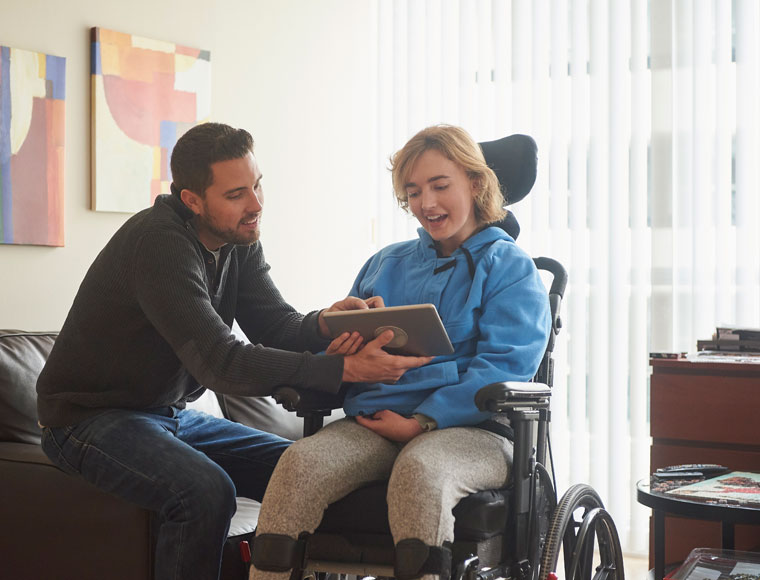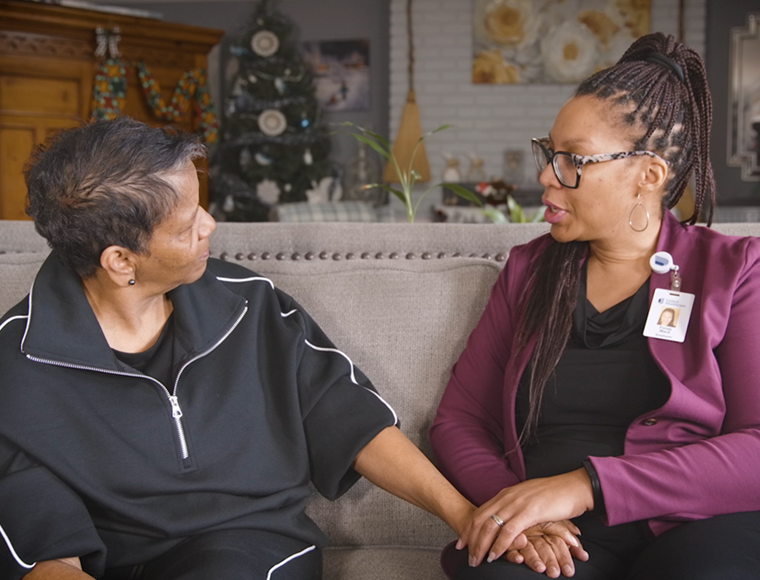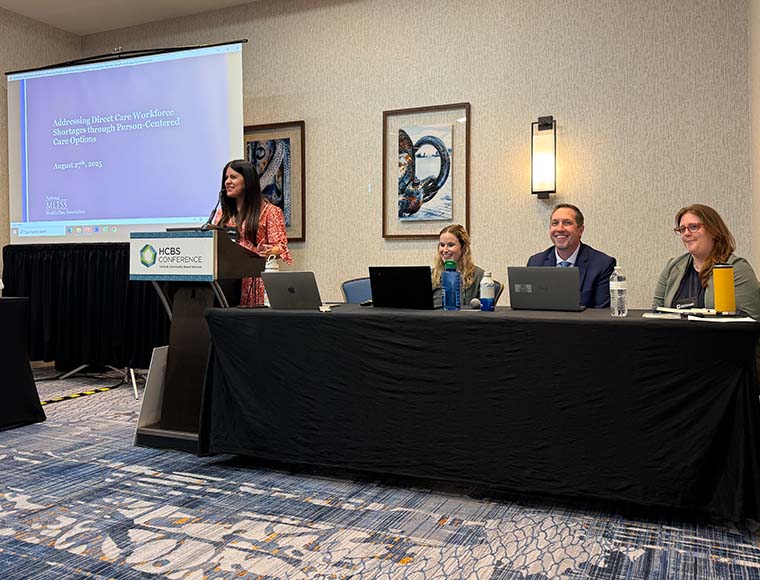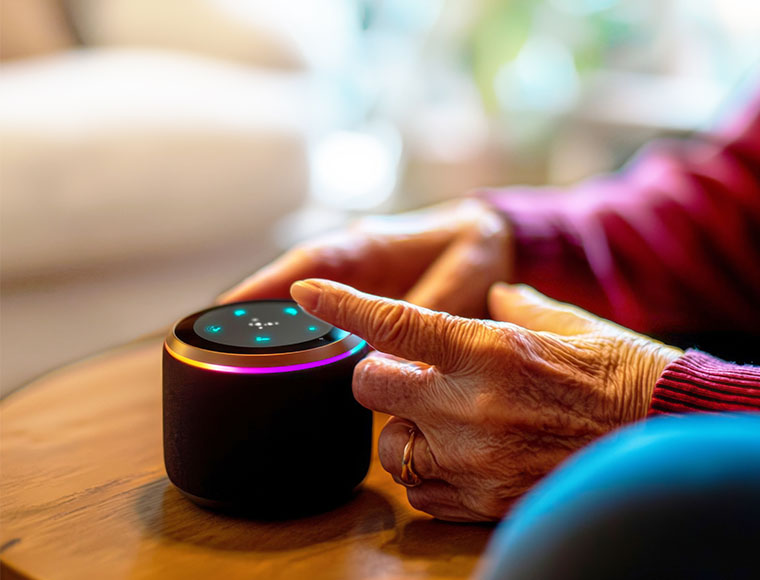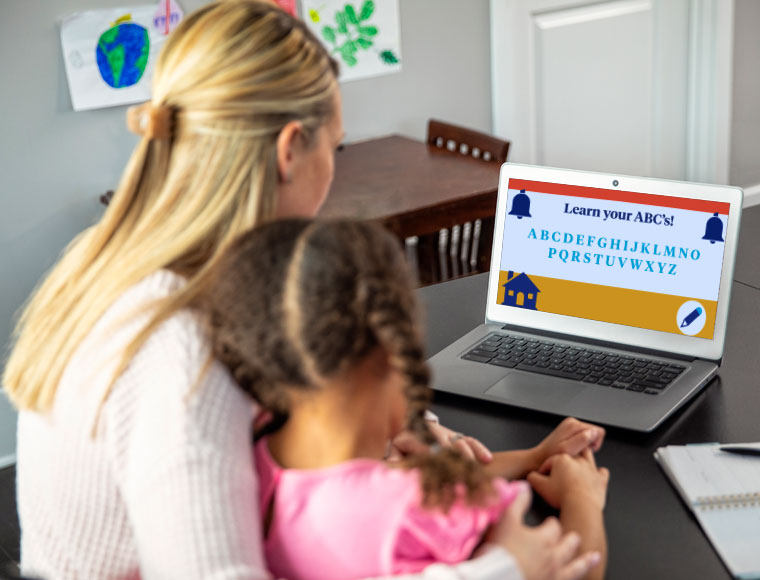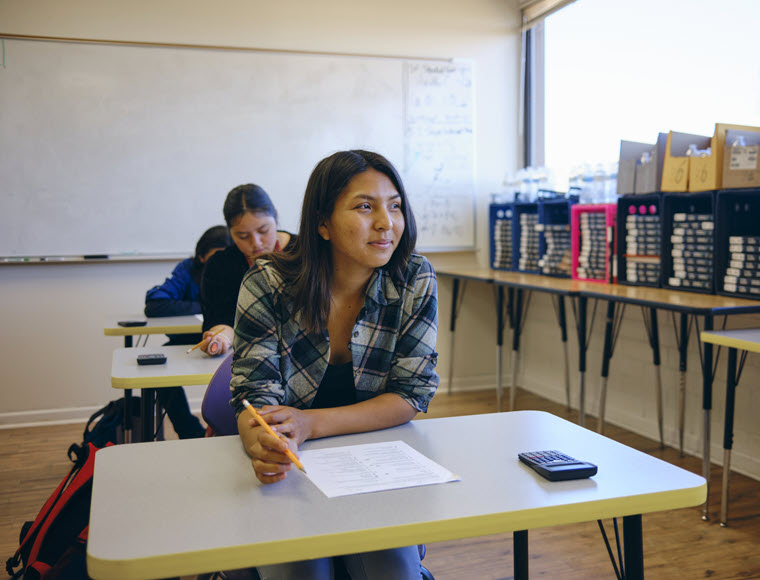There are an estimated 43 million family caregivers nationwide1 providing support or assistance for loved ones with acute, chronic and/or disabling health conditions. Caregiving is defined as the action needed as a result of a medical, behavioral, or other condition or disability.2
$470 Billion in care provided by informal caregivers in 2013
As more than half of the family care recipients today are under age 75, and almost one-third under age 50, the demand for caregivers will only increase over the coming years.4
Despite acknowledged economic and social benefits of care provided by family caregivers, challenges persist. Delaying nursing home, institutional, or foster care placement of just one individual for several months can save Medicaid, child welfare, and/or other government programs tens of thousands of dollars.5 Challenges faced by “family”6 caregivers range from emotional and physical to financial. Family caregivers are faced with having to learn new roles such as administering medications, helping the patient navigate complex systems, providing social supports, managing accounts and filing claims, and learning how to care for themselves while caring for another individual. All of these challenges are common among those who provide care. Delivery of care ranges from providing support for a child with disabilities to those caring for an elderly parent. These challenges are explored in this paper, followed by a review of opportunities to improve the quality of life for the caregiver, and in turn, for the person being supported
Background
Family members or friends are often called upon to provide care for children, particularly if they have a disability, or for a spouse, a parent, or a sibling with a disability or serious illness.
For parents of children with disabilities, the situation can be especially challenging as the parent caregiver ages, and their ability to continue to care for their child is limited. In other cases, a debilitating illness or disability of a spouse or other family member may place an individual unexpectedly in the caregiver role. Often this new role comes with little preparation, immediate expectations, and few formal supports.
Increased emphasis on home-based care and medical advances that allow persons with advanced illness and disabilities to be cared for in their homes has increased the amount and complexity of care that is delivered in the home. As a result, family caregivers are increasingly expected to provide health care services in the home that were once provided in a medical setting or provided in the home by trained professionals. Often, family caregivers receive little or no training about the medical tasks they are called on to provide. The demands of caregiving can take a significant toll on those providing care — physically, emotionally and financially. As more care is provided in the home, rather than in medical facilities, these challenges are likely to increase. The following statistics define the dilemma we face:
- Family caregivers are the foundation of the health care system in the United States, supporting advances in treatment provided in outpatient and home settings.7
- In 2013, about 40 million family caregivers in the United States provided an estimated 37 billion hours of care to adults with limitations in daily activities.8 The estimated economic value of their unpaid contributions was approximately $470 billion in 2013, up from an estimated $450 billion in 2009.9
- In 2009, there were an estimated 16.8 million family caregivers who provided care to a child with health care needs under the age of 18 in the U.S.10
- Almost half of family caregivers perform medical or nursing tasks, and of these, three-fourths manage medications, including administering intravenous fluids and injections.11
The number of family caregivers available for caregiving is declining from 7:1 in 2010 to 4:1 by 2030
Challenges facing family caregivers
Highlighted below are some of the many challenges faced by family caregivers. The list below is not exhaustive and is intended to provide insights to inform solutions to help individuals as they care for loved ones.
Emotional and financial difficulties
Helping to care for a loved one can exact a steep emotional toll. One study found that as many as one in three caregivers rate their stress level as high, and half say they have less time to spend with family and friends.13 Nearly 4 in 10 family caregivers of adults report experiencing financial strain as a result of providing care.14
High expectations with few formal supports
Family caregivers are often expected to immediately assume a wide range of responsibilities – many of them new to the individual and often with few formal or informal supports.
Expectations include, but are not limited to, the following.15
- Understanding, integrating and using new medical information;
- Learning new illness-related terminology;
- Entering new treatment settings;
- Finding time to accompany the family member to medical appointments;
- Completing administrative tasks (case management, management of insurance claims, bill payment);
- Performing instrumental tasks (running personal errands; managing cooking, cleaning, and other housekeeping tasks);
- Navigating health delivery and support systems;
- Providing companionship and socialization; and
- Finding time for themselves:
- Caregivers providing substantial help were more than 5 times as likely to report that their care duties interfered with valued activities, such as visiting friends and attending religious services16
- Caregivers report having difficulty finding time for themselves (35%), managing emotional and physical stress (29%), and balancing work and family responsibilities (29%);17
- Caregivers report they do not go to the doctor because they put their family’s needs first (67% said that is a major reason), or they put the care recipient’s needs over their own (57%); and
- More than half (51%) of caregivers report they do not have time to take care of themselves and almost half (49%) said they are too tired to do so.19
Caregivers may be 3x more likely to lose work productivity due to both hours of work missed because of caregiving and decreased work due to distraction and/or fatigue.
Work-family balance
Balancing caregiving and work is a substantial challenge and potential financial issue if the caregiver must or chooses to provide care instead of working. Employer recognition of the role and responsibilities of caregivers can be a vital source of support.
Aging
In addition to the aging of those needing care, caregivers themselves are aging. Advanced planning is required to ensure continuous care. Moreover as the baby boomers age, the supply of family caregivers is unlikely to keep pace with future demand.20
In 2010, the caregiver support ratio (the number of potential caregivers aged 45–64 for each person aged 80 and older) was more than 7 potential caregivers for every person in the high-risk years of 80-plus. By 2030, the ratio is projected to decline sharply to 4 to 1; and it is expected to further fall to less than 3 to 1 in 2050, when all boomers will be in the high-risk years of late life.21
Caregiving needs for persons with mental illness or psychiatric disabilities
There are unique challenges for caregivers caring for persons with mental illness, these include:
- Stigma which may limit an individual’s ability to reach out for assistance and respite resulting in isolation;
- Illness symptoms and behaviors that may make caregiving particularly challenging; and
- Needs for Instrumental activities of daily living (finances, transportation, etc.) in addition to physical care needs.
Caregiving for persons with intellectual and/or developmental disabilities (ID/DD)
There are approximately 2.9 million family caregivers of individuals with ID/DD in the U.S.22 According to the Arc’s Family and Individual Needs for Disability Supports (FINDS) survey, most of these family caregivers provide more than 40 hours of care per week, including the 40% who provide more than 80 hours of care per week.
Like other family care givers those caring for individuals with ID/DD are also aging. There are over 860,000 caregivers of individuals with ID/DD over the age of 60 (of a total of 2.9M family caregivers of persons with ID/DD); this number is projected to grow substantially with the aging of the baby boomer generation.23 Individuals with ID/DD are also living longer. As the parents of individuals with ID/DD age, they too will require increasing support to continue providing care to their adult children while also attending to their own needs.24 Because caregivers and those needing care are continuing to age, responsibility for caring for individuals with ID/DD is increasingly shifting to siblings – who may one day face many of the same challenges as their parents.
Lifelong caregiving for individuals with ID/DD can also have long-term negative economic impacts on families. In addition to sacrificing employment opportunities for their caregiving roles, many families incur significant medical expenses.
In 2009, families spent an average of $6,300 on out-of-pocket family support expenses
Caregiver’s rights under the Health Insurance Portability and Accountability Act (HIPAA)
Family caregivers may encounter challenges in accessing medical information that is essential to the caregiving, particularly for persons with mental illness. It is crucial that caregivers understand medical privacy protections HIPAA permits sharing of patient information with family and other caregivers if the patient does not object. Health care providers may however share or discuss only the information that the person involved needs to know about the patient’s care or payment for care.26 This may limit the information that is shared with the family caregiver. Other applicable laws (e.g., state confidentiality statutes) or professional ethics may impose further limitations on sharing personal health information, particularly where the information relates to a patient’s mental health.
Acknowledgment of the role of caregiver
In many cases, family caregivers may not be recognized as caregivers because it’s not a role that is clearly distinct from their familial role. As a result, services and supports may not be readily offered or available. Family caregivers themselves may not view their role as distinctive and may be reluctant to seek or accept assistance and support.
In addition, individuals being cared for may themselves not perceive or accept a need to be cared for. This may be particularly acute for persons with mental illness, Alzheimer’s disease, etc. These situations may result in requests for assistance only in a crisis or emergency situation.
Opportunities to help support family caregivers
UnitedHealthcare Community & State engaged the expertise of a National Advisory Board (NAB) to provide input into the design of new or enhanced systems and supports for family caregivers. The NAB, which is composed of leading experts in aging and disability, including a Community & State health plan member, a direct care worker, and a family caregiver of a child with special health care needs, provided UnitedHealthcare Community & State with guidance and input to promote a better understanding of the needs of family caregivers and of the programs and services that can best support these individuals.
The following recommendations reflect the NAB’s input and guidance and are intended to address identified challenges. UnitedHealthcare Community & State is positioned to implement a pilot in select Medicaid markets to incorporate many of the individual recommendations offered below.
1. Ensure States Are Aware of and Fully Utilize Existing Medicaid Authorities to Support Family Caregivers
2. Assess Needs of Family Caregivers
3. Leverage, Expand and Promote Evidence- Based Caregiver Education, Training and Information Resources
4. Minimize Family Caregiver Administrative and Paperwork Burden
5. Promote Peer-To-Peer Networking and Respite Opportunities
6. Ensure Population, Cultural and Language- Appropriate Resources
7. Provide Targeted Resources for Individuals Caring for Children with Disabilities
8. Support Programs Such as Virtual Caregivers / Care Teams / Co-Ops
9. Explore Continuation and /or Expansion of Proven Effective UnitedHealthcare Initiatives
10. Continue to Explore the Use of Telehealth and Remote Patient Monitoring
11. Implement Targeted Pilots to Leverage Ongoing Initiatives and Test New Family Caregiver Supports
1. Ensure states sre sware of and fully utilize existing medicaid waiver authorities
Existing Medicaid authorities can be used to strengthen caregiver supports. Promotion of and education regarding these programs should be broadly available and accessible. These authorities including the following:
- Section 1915(c) waivers allow states to provide respite care, training and family counseling to meet the needs of individuals preferring LTSS in their home or community. Many states permit individuals to directly hire family members in waiver programs and state plan options.
- The Medicaid State Plan Option for Home and Community- Based Services, Section 1915(i) of the Deficit Reduction Act (DRA) of 2005 enables States to provide home and community-based services as a State plan option. Under this option, States may provide some of the same services to caregivers that are available under 1915(c) waivers.
2. Assess the needs of family caregivers
It is critical to identify and assess the needs of family caregivers. A caregiver assessment asks questions of the family caregiver relevant to their everyday needs. It is a systematic process of gathering information about a caregiving situation to identify the specific problems, needs, strengths, and resources of the family caregiver, as well as the caregiver’s ability to contribute to meeting the needs of the care recipient.27 The assessment should be helpful and non-threatening, seek to identify individual preparedness and capacity to be a caregiver and approach issues from the caregiver’s perspective and culture. Assessments should be carefully structured to best determine what types of assistance may be needed to support the caregiver, assure their health and well- being, and to develop a care plan that includes identified assistance and supports. CMS has required caregivers assessments for unpaid caregivers as part of 1915(i) waivers. Some states, such as Tennessee, have required caregivers assessments in MLTSS programs.28
3. Leverage, expand and promote evidence-based caregiver education, training and information
Many existing tools and informational resources are currently available to assist, support and inform family caregivers. Assuring that family caregivers are aware of these resources, know how to access them and that these resources are easy to understand is critical. Examples of the types of information and assistance that can benefit and support family caregivers include the following:
- How to develop an emergency preparedness plan; created as early as possible in the caregiving trajectory.29
- Assistance with logistical and financial planning to address evolving needs of the person being cared for and planning for future transitions as both the patient and the caregiver age. An example of this is the creation of a “toolkit” for future planning.
- Guidance on working with providers to ensure communication of information between the provider and caregiver about the disease or disability, its treatment, related symptoms and side effects. Specifically, family caregivers have shown a need for instructions in the following:
- Which medications to use for pain/symptom relief;
- When to give a medication (dosage and frequency);
- How to assess the efficacy of pain control/ symptom relief;
- Symptom etiology;
- What to expect in the future;
- Treatment side effects;
- Management of medical emergencies;
- How to monitor for side effects; and
- How to identify negative results or ineffectiveness.
- Information and education on non-pharmacologic strategies for symptom management, including:
- Massage;
- Use of heat and cold compresses;
- Energy conservation;
- Rest and restoration strategies;
- Relaxation; and
- Distraction.
- Information tailored to a caregiver’s situation and characteristics of the individual being cared for. Information provided in an easily-accessible and timely manner helps to reduce the stress of caregiving and associated feelings of inadequacy and helplessness. By providing information about the patient’s disease or disability trajectory, and the range of emotions likely to be experienced, the family caregivers’ sense of control is enhanced and feelings of helplessness or confusion can be reduced. Caregivers can derive emotional support from time spent with professionals and from educational resources that help define what is “normal” to expect and to feel.
- Skills training for caregivers that reflect the needs of the person being cared for. Research on family caregivers for individuals with cancer suggests that the most effective skill training programs tend to be nursing intervention programs, which combine guidance, support and nursing care in the home. Nurse-led transition coaching programs prepare patients and caregivers for the next level of care, teach communication skills and support patients in the home.30 The Family Caregiver Cancer Education Program targets education about symptom management along with skill-building in communication, managing roles and relationships, managing finances, and maintaining self-care.31 After participation in the program, caregivers’ sense of confidence and understanding in their loved ones needs increased, while perceptions of their own health improved over time.
- Counseling and psycho-education reduce distress by helping caregivers adjust to the demands of caregiving. These interventions are typically designed to enhance morale, self-esteem, coping and sense of control while reducing anxiety and depression. Individual counseling is designed to provide caregivers with support, education and problem-solving or coping skills.
- Information on local Family Caregiver Support Agencies. Locally-based agencies, such as home care, area offices on aging, senior centers and other social support agencies, can help family caregivers with a variety of tasks including coordinating appointments, providing transportation, and relaying communication from the doctor about the plan of care. Family caregivers should consider whether these agencies are available in the community to provide respite for the caregiver and or offer referrals for support and assistance.
- Information and Resources to Support Providers and Care Managers in States that have implemented the Caregiver Advise, Record, Enable (CARE) Act. The CARE Act supports family caregivers when loved ones go into the hospital by requiring the following: that the name of the family caregiver is recorded when a loved one is admitted into a hospital or rehabilitation facility; that the family caregiver is notified if the loved one is to be discharged to another facility or back home; and that the hospital or rehabilitation provide an explanation and live instruction of the medical tasks – such as medication management, injections, wound care and transfers – that the family caregiver will need to perform at home.
Further evaluation of the types of information that should be conveyed by Managed Care Organizations (MCO’s) to family caregivers and careful assessment of most effective mechanisms for information delivery is recommended.
Mechanisms for sharing information may include:
- Online
- Interactive Handheld Devices
- Webcasts
- Computerized information systems
- Booklets, pamphlets, fact sheets, and information cards
- CD’s and DVD’s
4. Minimize administrative and paperwork burden
Excessive and confusing administrative requirements and paperwork are reported to be a challenge for family care givers. Work to identify duplicative or confusing paperwork and surface best practices to streamline paperwork and reduce complexity for family caregivers is recommended.
5. Promote peer-to-peer networking and respite opportunities
Isolation and lack of information are frequent challenges of family caregiving. Peer-to-peer networking has been noted as an efficient and effective strategy to provide much needed support, including respite, and guidance for family caregivers. Networking may be facilitated through organized social events, health fairs, caregiver meetings, conference attendance, continuing education and other community-based opportunities, including through partnerships with local agencies and organizations. Networking may be conducted in-person, virtually or through a hybrid of the two, for example via online sessions held at community spaces such as libraries.
A notable model of peer supports is provided by the Department of Defense (DoD).32 The DoD’s Caregiver Peer- to-Peer Support Initiative provides face-to-face, confidential, non-medical counseling to service and family members, including caregivers. Beginning in 2014, military and family life counselors in Army, Marine Corps, and Navy and Air Force installations with recovery care coordinators began to organize and conduct voluntary peer-to-peer forums to provide confidential, non-medical counseling to caregivers. For military caregivers who do not live near a military installation or are unable to attend a local group forum, military caregiver peer support webinars are held. These forums can positively impact caregivers’ quality of life by reducing stress, providing emotional support and acting as a resource for valuable information. A community of caregivers can directly help each other in ways no other program or professional can. Caregivers can provide practical, accurate and thorough advice based on real life experience.
Respite provides temporary relief to caregivers from the ongoing responsibility of caring for individuals. Respite care is one of the most commonly requested caregiver support services and has been shown to provide family caregivers with the relief necessary to maintain their own health, balance work and family, bolster family stability, keep marriages intact, and avoid or delay more costly nursing home or foster care placements.
Caregiver respite may be informal, through friends and neighbors, or formal through a contracted agency and may be companion care, personal care (to help with daily activities) or adult day care. The Lifespan Respite Care Program, authorized by Congress in 2006, supports coordinated systems of accessible, community-based respite care services for family caregivers of children and adults of all ages with special health care needs. Under the Lifespan program grants are made to individual states. While the exact services and procedures are specific to the individual state all are intended to support the following:
- Expand and enhance respite services in the states;
- Improve coordination and dissemination of respite services;
- Streamline access to programs;
- Fill gaps in service where necessary; and
- Improve the overall quality of the respite services currently available.
Since 2009, Congress has appropriated approximately $2.5 million annually to implement Lifespan Respite Programs. As of 2016, competitive grants of up to $200,000 each were awarded to eligible agencies in thirty-five states and the District of Columbia.33 Ongoing support of mechanisms and programs to provide respite for family caregivers, in a manner that both leverages existing successful models and that explores novel means of providing these supports, is a recommended strategy.
6. Ensure population, cultural and language- appropriate resources
Resources for family caregivers should be targeted to reflect the characteristics of the individuals receiving care. The nature and outcomes of family caregiving are different for various sub-groups. These outcomes vary as a function of the characteristics of the individual receiving care such as: socioeconomic status, gender, age, cultural/ethnic traditions, values and beliefs, minority status, and degrees of acculturation and assimilation.
Factors such as socioeconomic status, familial interdependence, and level of acculturation, immigration status, and fear of stigma in response to a disease or physical disability may influence whether and how families engage in caregiving. These differences may also make some family caregivers less likely to seek or to accept social and professional support services.
For example, in 2009 among the U.S. adult population, approximately one-fifth of both the non-Hispanic White and African-American populations provided care to a loved one, while a slightly lower percentage of Asian-Americans, 18 percent, and Hispanic Americans, 16 percent, were engaged in caregiving.34 Existing resources must be reviewed to ensure that resources are sufficiently targeted and reflect care and treatment specific to the:
- Elderly;
- Individuals with multiple chronic and/or acute diseases;
- Individuals with intellectual and/or developmental disabilities;
- Persons with behavioral health needs;
- Parents of young children, under the age of five;
- Language spoken in the home; and
- Cultural norms, beliefs and traditions.
7. Provide targeted resources for individuals caring for children with disabilities
Individuals caring for children face unique and distinct challenges that must be addressed with targeted, child- specific interventions and supports. The most salient of these supports, as evidenced through previous research and analysis, include:
- A Medical Home Toolkit or a Care Notebook for the family caregiver provided as a resource as early as possible in the caregiving journey;
- Creation of a “toolkit” for future/transition planning for the family;
- Development and support of personal networks, beginning as early as 14;
- School-based supports and programs;
- Information on how to deal with the early childhood development through the teenage years and young adult hood;
- Tools for parents of young children birth –5 years may include35
- Tools or referrals to help with understanding feelings about having a child with a disability or special health- care needs;
- Creation of and/or referrals to support networks to connect with other parents with similar experiences;
- Information on home safety and special equipment and tools designed for people with disabilities or special health-care needs to help them do more, experience more, and build on their abilities;
- Respite care for the parent and day care for the child – how and where to look for these services;
- Tools to help parents deal with difficult or uncomfortable situations including public perceptions of children with disabilities; and
- Financial services including trust funds and setting up power of attorney for individuals before they turn 18 to ensure that parent caregivers have access to critical information.
To ensure maximum success it is essential that caregiver resources be targeted to, and reflects the characteristics of unique populations.
8. Support novel support programs such as virtual caregivers / care teams / co-ops
Innovative support models for family caregivers must continue to be explored, promoted, supported and implemented. Successful models have included cooperatives in which individuals volunteer their time to a community respite program for a given number of hours each week. These novel solutions provide family caregivers an affordable way to take turns caring for one another’s family members in exchange for respite time, gives caregivers more time for themselves and fosters a sense of community among both those who give and receive care.
An example of this model is the Asian Community Center of Sacramento Valley Inc. (ACC),36 a nonprofit organization providing culturally sensitive health and social services for older adults. This program allows caregivers to “buy” caregiving time for their family member in the cooperative through volunteering once a month. With minimal supervision from ACC staff, caregiving volunteers planned and led activities for the program which operated once a week and provided up to five hours of recreation, socialization, physical exercise and mental stimulation to older adults with dementia and physical limitations. The cooperative provided over 9,000 respite hours to more than 150 caregiver co-op members. Caregiver feedback was incorporated back into the program through several feedback mechanisms such as evaluations, face-to-face interviews, and meetings.
Local organizations are well-suited to engage in support of innovative models in their community. Such organizations might include (but are not limited to):
- In-home care agencies;
- Meals on Wheels;
- Area Agency on Aging;
- Social Service Agencies; and
- Disease-specific agencies such as the American Cancer Society.
9. Explore continuation and /or expansion of proven effective UnitedHealthcare initiatives
UnitedHealthcare operates numerous initiatives that support family caregivers. For example, as a part of UnitedHealthcare’s “Solutions for Caregivers” program, local Community Health Workers (CHWs) evaluate and support care for both patients and their caregivers. This effective model, which currently provides caregiver supports in Tennessee and Florida, should be explored for best practices possible replication in other states. Under this model:
- Referrals are provided to caregivers for telephonic consultation and administration of stress assessments (using the AMA caregiver assessment tool)
- Telephonic education is offered monthly for caregivers and open to all who are interested.
“Solutions for Caregivers” and other UnitedHealthcare initiatives can serve as successful models for future initiatives.
10. Continue to explore the use of telehealth and remote patient monitoring
Telehealth and remote patient monitoring devices can provide important support for family caregivers. Digital devices can assist family caregivers by collecting vital signs and instantly delivering information to a remote caretaker or a physician. Much like a security monitor, remote patient monitoring devices use wireless sensors to check on a person’s sleeping, eating, movement patterns and habits. If there is a significant change in these patterns, the caretaker and/or provider can be alerted. Telehealth and remote patient monitoring devices may be of significant benefit as an adjunct to other caregiver supports.
11. Implement targeted pilots to test new family caregiver supports
UnitedHealthcare Community & State is committed to improving the well-being of family caregivers. To that end UnitedHealthcare Community & State will explore pilot initiatives in select states to leverage and extend existing UnitedHealthcare Community & State initiatives to best address the challenges highlighted throughout this paper.
The pilots will be structured to promote optimal health outcomes by assuring family caregivers access to needed information and training, peer supports and community resources. As part of the pilot, we will ensure referral of family caregivers to on-line educational resources to support the complex care provided in the home. In addition, we will work to develop and promote educational tools to ensure that in states that have enacted the CARE Act, providers and care managers are aware of and provided the resources needed to effectively implement the requirements of the Act. The Care Act supports family caregivers when a loved one is admitted to the hospital by recording vital information, keeping loved ones informed throughout their hospital stay and providing explanation and live instruction of medical tasks that need to be performed once the loved one returns home.
UnitedHealthcare Community & State is committed to improving the well-being of family caregivers. To that end UnitedHealthcare Community & State will explore pilot initiatives in select states to leverage and extend existing UnitedHealthcare Community & State initiatives to best address the challenges highlighted throughout this paper.
The pilots will be structured to promote optimal health outcomes by assuring family caregivers access to needed information and training, peer supports and community resources. As part of the pilot, we will ensure referral of family caregivers to on-line educational resources to support the complex care provided in the home. In addition, we will work to develop and promote educational tools to ensure that in states that have enacted the CARE Act, providers and care managers are aware of and provided the resources needed to effectively implement the requirements of the Act. The Care Act supports family caregivers when a loved one is admitted to the hospital by recording vital information, keeping loved ones informed throughout their hospital stay and providing explanation and live instruction of medical tasks that need to be performed once the loved one returns home.
Sources
- https://www.govtrack.us/congress/bills/114/hr3913/text. Accessed October 20, 2016.
- http://www.caregiving.org/data/Report_Caregivers_of_Children_11-12-09.pdf
- http://disabilitiescaucus.langevin.house.gov/rss.xml. Accessed October 20, 2016.
- https://www.caregiver.org/caregiver-statistics-demographics
- Ibid.
- Family caregivers are broadly defined as family members, friends, or neighbors who provide unpaid assistance to a person with a chronic illness or disabling condition. The nature of the assistance could include helping the person with Activities of Daily Living (ADLs) or Instrumental Activities of Daily Living (IADLs); performing “medical” tasks such as administering intravenous drugs or caring for wounds; acting as the person’s legal representative; or other activities.
- Schumacher KL, Stewart BJ, Archbold PG, et al.: Effects of caregiving demand, mutuality, and preparedness on family caregiver outcomes during cancer treatment. Oncol Nurs Forum 35 (1): 49-56, 2008.
- Ibid.
- http://www.aarp.org/content/dam/aarp/ppi/2015/valuing-the-invaluable-2015-update-new.pdf
- http://www.caregiving.org/data/Report_Caregivers_of_Children_11-12-09.pdf
- http://www.aarp.org/politics-society/advocacy/info-2015/focus-on-unpaid-family-caregivers.html
- http://www.aarp.org/politics-society/advocacy/info-2015/focus-on-unpaid-family-caregivers.html
- http://www.aarp.org/relationships/caregiving/info-06-2010/crc-10-caregiver-stress-managment-tips.html?intcmp=AE-POL-IL
- National Alliance for Caregiving (NAC) and AARP Public Policy Institute, Caregiving in the U.S., 2015.
- Glajchen M: Role of family caregivers in cancer pain management. In: Bruera ED, Portenoy RK, eds.: Cancer Pain: Assessment and Management. 2nd ed. New York, NY: Cambridge University Press, 2009, pp 597-607.
- https://www.nih.gov/news-events/nih-research-matters/invisible-work-toll-among-family-unpaid-caregivers
- NAC, 2004
- https://www.nih.gov/news-events/nih-research-matters/invisible-work-toll-among-family-unpaid-caregivers
- Ibid.
- http://www.aarp.org/content/dam/aarp/research/public_policy_institute/ltc/2013/baby-boom-and-the-growing-care-gap-insight-AARP-ppi-ltc.pdf
- http://www.aarp.org/content/dam/aarp/research/public_policy_institute/ltc/2013/baby-boom-and-the-growing-care-gap-insight-AARP-ppi-ltc.pdf
- http://www.thearc.org/page.aspx?pid=3378
- http://www.thearc.org/what-we-do/public-policy/policy-issues/family-support
- http://www.thearc.org/what-we-do/public-policy/policy-issues/family-support
- Ibid.
- See 45 CFR 164.510(b)
- http://www.aarp.org/home-family/caregiving/info-11-2013/including-family-caregiver-assessment-in-medicaid-hcbs-waive-programs-AARP-ppi-ltc.html
- http://www.aarp.org/content/dam/aarp/ppi/2016-08/AARP1080_FSandMLTSS_REPORT_WEB.pdf
- https://www.disability.gov/resource/disability-govs-guide-emergency-preparedness-disaster-recovery/
- https://www.cancer.gov/about-cancer/coping/family-friends/family-caregivers-hp-pdq
- Ibid.
- http://www.defense.gov/News/Article/Article/604677, accessed October 25, 2016.
- https://www.payingforseniorcare.com/respite-care/lifespan-respite-care-program.html
- http://www.apa.org/pi/about/publications/caregivers/faq/cultural-diversity.aspx
- **See the following links for more information: http://www.parentcompanion.org/about; https://www.navigatelifetexas.org/en
- http://www.accsv.org/

